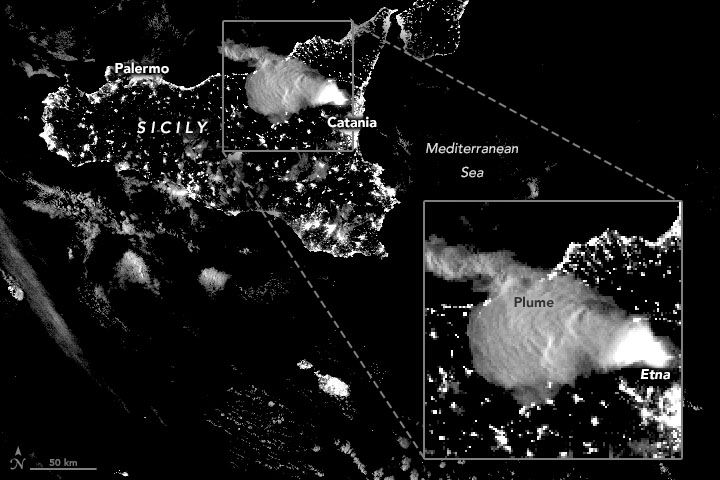Mount Etna erupts, seen from space on February 18, 2021. (Image credit: Landsat data from the US Geological Survey)
Mount Etna spat lava in Sicily for weeks during a series of eruptions captured by a series of satellites orbiting the Earth.
Etna, the most active volcano in all of Europe, has been in a state of eruption since 2011. The last series started on February 16. The volcano erupted that day, again on February 18 and again between February 20 and February 23. During these eruptions, lava fountains shot high in the night sky, reaching 0.4 miles (0.7 kilometers) in height at the beginning of the month and reaching 0.9 miles (1.5 km) above the top of the volcano at the end of the month.
These more recent eruptions “were among the most violent in the young history of the Southeast crater,” Marco Neri, a volcanologist at Italy’s National Institute of Geophysics and Volcanology, said in a NASA statement.
Related: Asteroid impact, not volcanic activity, killed the dinosaurs
Earth observation satellites were eager to check the smoke, ash and lava launched from the volcano. On February 18, the Operational Land Imager (OLI) of the NASA-US Geological Survey Landsat 8 satellite captured a natural colored view of the volcano, which was superimposed with infrared data to show the hot areas (or points where the lava had burst)
In this image taken from space, you can see Mount Etna in Italy, one of the most active volcanoes in the entire world, erupting. The image was captured on February 18 by the European Space Agency’s Copernicus Sentinel-2 mission, which is composed of two different orbiting Earth observation satellites. The volcano erupted twice in less than 48 hours, spewing ash and a lava source, which erupted on February 16 and again on February 18. (Image credit: contains modified data from Copernicus Sentinel (2021), processed by ESA, CC BY-SA 3.0 IGO)
Also on February 18, the European Space Agency’s Copernicus Sentinel-2 mission, made up of two satellites, observed the eruption. European satellites captured a moment that, using infrared images, showed the lava in bright orange and red.
Mount Etna erupted on February 23, 2021, seen by VIIRS in NOAA-20. (Image credit: NASA Earth Observatory image by Joshua Stevens, using VIIRS day-night band data from the Joint Polar Satellite System)
A few days later, when Etna erupted again on February 23, the US Oceanic and Atmospheric Administration’s NOAA-20 satellite captured an image with its VIIRS instrument (Visible Infrared Imaging Radiometer Suite) that highlights the plumes coming from the volcano .
Landsat 8 looked at the volcano again on February 25, this time at night. Using short wave thermal and infrared bands, he was able to show the lava below based on the heat coming out of it.
While these recent eruptions have been impressive, they have caused minor disturbances rather than major damage to the surrounding area, according to the NASA statement. The ash from Etna temporarily closed the airport in Catania and was deposited in Sicily, for example, and local residents had to deal with falling ash and stones.
Send an email to Chelsea Gohd at cgohd@space.com or follow her on Twitter @chelsea_gohd. Follow us on Twitter @Spacedotcom and Facebook.

